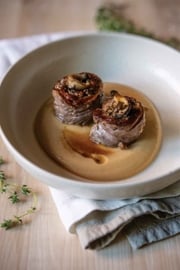Turkey Meatballs with Tomato Confit

Turkey is an excellent source of tryptophan, helpful for rest and calm, plus the dark meat is high in iron. Served with Tomato Confit, this is a dish packed with antioxidants. Try this dish as a tasty little appetizer or serve as a main course with quinoa, couscous, rice, or noodles.
Tomato Confit
28 oz (796 mL) can plum tomatoes
2 garlic cloves, finely minced
1 jalapeno, seeded and very finely minced
Juice from 1 lemon
1/3 cup (80 mL) extra-virgin olive oil
1 Tbsp (15 mL) red wine vinegar
2 Tbsp (30 mL) finely chopped Italian parsley
Sea salt and freshly ground black pepper
Turkey Meatballs
1 lb (450 g) organic ground turkey meat (combination of turkey thigh and breast meat)
4 green onions, finely minced
1/4 cup (60 mL) each of minced mint leaves, cilantro, and Italian parsley
Finely grated zest from 1 lemon
1 garlic clove, very finely minced
1/4 tsp (1 mL) sea salt
Freshly ground white pepper
2 Tbsp (30 mL) extra-virgin olive oil
2 cups (500 mL) baby arugula, washed and spun dry
Drain tomatoes and squeeze out seeds. Finely dice and place in bowl along with garlic, jalapeno, and lemon juice. Fold together. In small bowl, whisk oil, vinegar, and parsley together. Drizzle over tomatoes and add salt and pepper to taste. Set aside to marinate while preparing turkey meatballs.
Preheat oven to 350 F (180 C). Line baking sheet with parchment paper. Combine meatball ingredients except olive oil and arugula in medium-size bowl. Work mixture together using hands until evenly mixed. Dampening hands with water, shape turkey mixture into 1 in (2.5 cm) round balls and place in single layer on baking sheet. Lightly brush with olive oil. Bake in preheated oven for 20 minutes or until meatballs are cooked through and inner temperature reads 170 F (77 C) when tested with meat thermometer.
To serve, place a few arugula leaves on each of 6 serving dishes. Top with a few turkey meatballs and spoon some Tomato Confit over top.
Serves 6 as an appetizer.
Each serving contains: 300 calories; 18 g protein; 22 g total fat (4 g sat. fat, 0 g trans fat); 10 g total carbohydrates (4 g sugars, 3 g fibre); 347 mg sodium
source: "Cancer Fighting Foods", alive #378, April 2014





